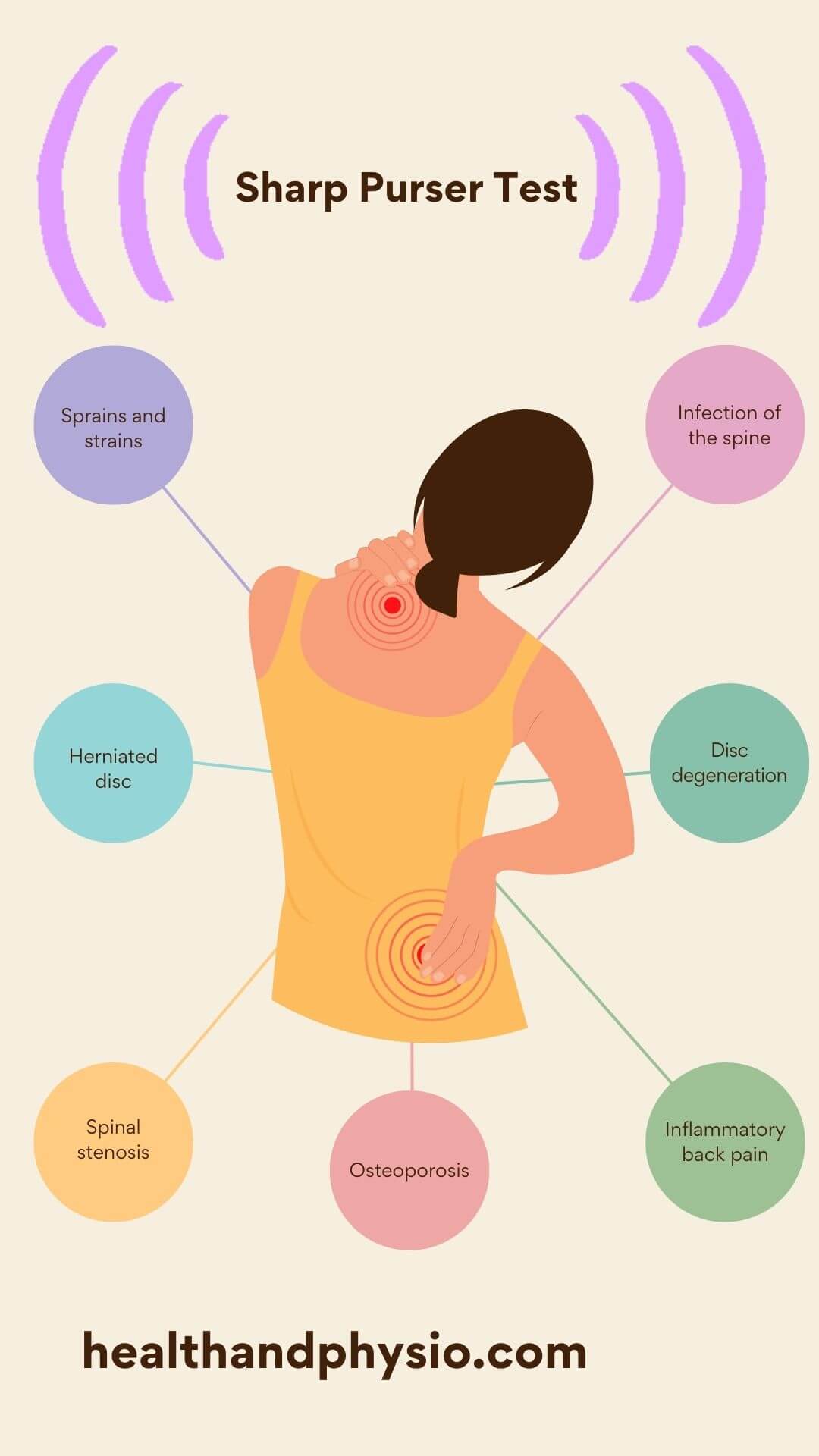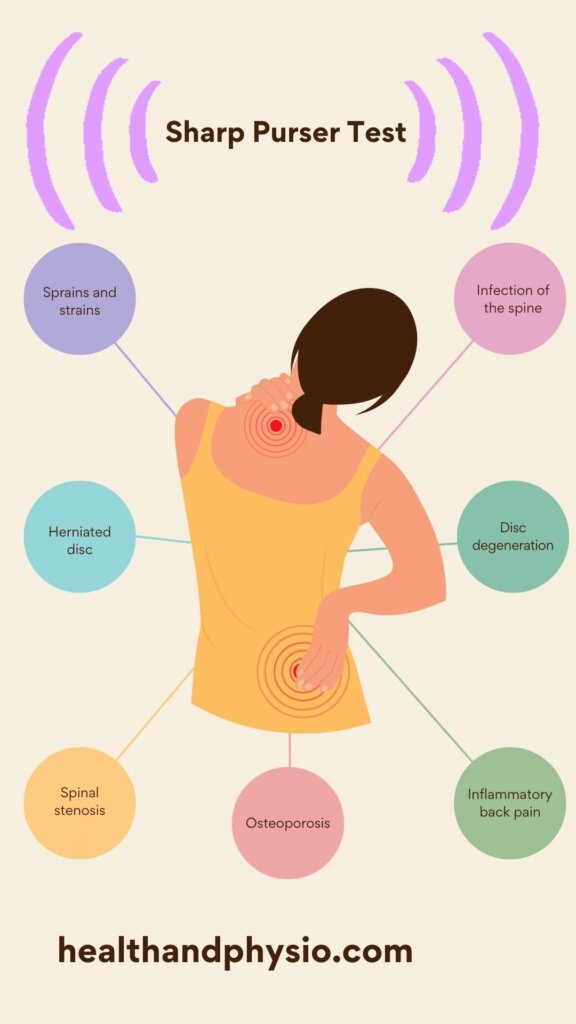Quick Overview
Sharp Purser Test ( also known as Transverse Ligament stress test) is a specialized diagnostic technique used to assess Atlantoaxial instability. The Atlanto-Axial joint is located between the first and second cervical vertebrae in the body and plays a crucial role in providing stability and allowing rotational movement of the neck. However, certain medical conditions, such as Atlantoaxial instability, can disrupt this delicate balance and lead to complications like quadriplegia.
Table of Contents
Atlanto-Axial Joint
The atlantoaxial joint is a pivotal joint that facilitates the rotational movement of the neck, composed of the atlas (C1) and axis (C2) vertebrae. This joint is supported by various ligaments, including the Transverse Ligament. The function of the Transverse Ligament is to provide stability by preventing the excessive anterior translation of the atlas on the axis.
Atlantoaxial Instability and its Causes
One of the common causes of Atlantoaxial instability is Rheumatoid Arthritis (RA), an autoimmune disorder in which the immune system of the body attack on its own healthy tissues causing inflammation (painful condition) including various joints in the body.
In RA, the inflammation and erosion of the ligaments can compromise the stability of the Atlanto-Axial joint. This instability can have a detrimental impact on the cervical spinal cord, leading to neurological symptoms such as weakness, numbness, and tingling sensation.
The Sharp Purser Test: A Technique for Diagnosis
The Sharp Purser Test is a specialized diagnostic technique used to assess Atlantoaxial instability. During this test, the patient is in a sitting position and the examiner places his hand on the forehead of the patient, making it slightly flexed, and applies a gentle posterior force to the forehead. This action creates tension on the Transverse Ligament and helps in identifying any excessive movement between the atlas and the axis.
Other Ligamentous Tests for Assessing Laxity
In addition to the Sharp Purser Test, various ligamentous tests, such as radiographs, are employed to evaluate Atlantoaxial instability. Radiographs provide valuable insights into the alignment and integrity of the Atlanto-Axial joint.
Clinical Implications and Associated Conditions
Atlantoaxial instability can lead to cervicogenic headaches (unilateral pain originating from the neck and extending to other areas due to issues with either the bones or soft tissues of the neck) and compromise upper cervical stability.
Another important stabilizer called Alar ligament, is often affected in this condition. Recognizing these implications helps in determining the most appropriate treatment approach for patients.
Side-Bending and Rotation Stress Tests
Side-bending and rotation stress tests are performed to assess the range of motion and evaluate the cervical spine. These tests help to identify any limitations or abnormalities that may contribute to Atlantoaxial instability. They provide valuable information for accurate diagnosis and treatment planning.
Atlanto-Occipital Joint
The atlantooccipital joint is situated between the base of the skull and the atlas (C1) vertebra and is closely interconnected with the Atlanto-Axial joint. Therefore dysfunction in one joint can affect the other, making a comprehensive evaluation essential. The suboccipital muscles also play a crucial role in maintaining stability in this region.
Red Flags and Upper Cervical Ligament Instability
It is important to recognize the red flags (unhealthy signs) associated with Atlantoaxial instability, such as severe neck pain, neurological deficits, or a history of trauma. Upper cervical ligament instability, including Transverse Ligament laxity, should be evaluated to determine the appropriate diagnostic tests, such as the Sharp Purser Test.
Factors Affecting the Sharp Purser Test Results
Several factors can influence the results of the Sharp Purser Test. False negative and false positive results may occur due to various reasons, such as patient cooperation or the severity of instability. The time required for performing the test is relatively short, making it a convenient diagnostic tool.
Manual Therapy and Pre-Manipulative Assessment
Manual therapy techniques can be beneficial in addressing Atlantoaxial instability. However, a thorough pre-manipulative assessment, including the Sharp Purser Test, should be conducted to ensure patient safety and identify any contraindications.
Prevalence Rate and Screening Test Recommendations
The prevalence rate of Atlantoaxial instability varies among different populations. Screening tests, such as the Sharp Purser Test, are recommended for individuals with specific risk factors or presenting with relevant symptoms. Timely identification and appropriate management can significantly improve patient outcomes.
Reliability and Validity of Anterior Shear Test
The Anterior Shear Test is another reliable test used to evaluate Atlantoaxial instability. Its high sensitivity and specificity make it a valuable tool in diagnosing this condition. It is particularly useful in detecting anterior shoulder instability, which may result from injuries, repetitive strain, or joint laxity.
Related Articles
Talar Tilt Test: Performance, Diagnosis, Treatment, Importance


